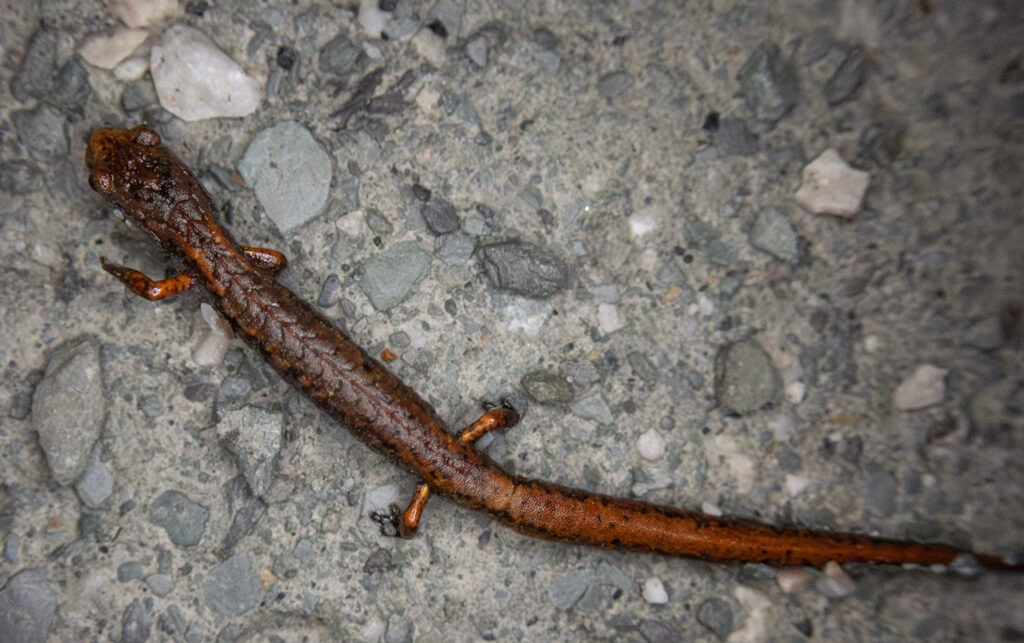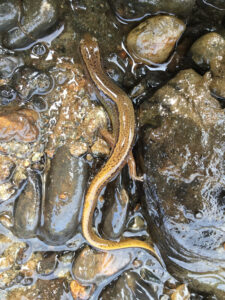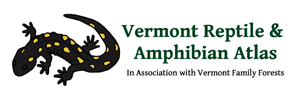
Herp Update: Fall Amphibian Migration, Snakes on the Move, Urban Herping, Fiscal Sponsor – October 16, 2024
Recent Herp Activity
Fall Amphibian Migration
Although spring amphibian migrations get the most attention, fall uphill migrations on warm rainy nights can also be quite substantial. Some amphibians that move to wetlands in the spring, move back uphill to feed within a few weeks after breeding and/or laying eggs. However, other amphibians stay in or near the wetlands to feed during the spring and early fall. These amphibians are now moving uphill to overwintering locations.
Looking at our last twenty years of fall-migration records from Morgan Road in Salisbury, we find three species that have been found migrating uphill in the fall with great regularity (200 or more total individuals): Blue-spotted Salamanders, Eastern Red-backed Salamanders, & Four-toed Salamanders.
There are additional herp species that have been seen during our fall night-time road searches at Morgan Road but they are either not abundant fall migrators, or they are moving for other reasons. At Morgan Road these include American Bullfrog, American Toad, Eastern Newt, Gray Treefrog, Green Frog, Northern Leopard Frog, Spotted Salamander, Spring Peeper, Wood Frog, and Common Gartersnake.
Eastern Red-backed Salamanders are by far the most commonly seen salamander during fall migrations at Morgan Road with 849 individuals reported, with the latest migration seen on December 17th. Data from other sites shows that Eastern Red-backs don’t migrate at all locations, only where the feeding and overwintering sites are separate.
Four-toed Salamanders are the second most frequently seen amphibian during fall migrations at Morgan Road with 249 reported over the last twenty years. Their latest migration date on record is December 12.
Blue-spotted Salamanders come in third with 200 reports and a latest recorded migration date of December 7.
Samantha Spaulding took the great photo below of a Four-toed Salamander in Orwell.

Snakes Still on the Move
On warm, sunny, days, snakes are still moving to their overwintering locations. Looking at all the snakes that have been found dead on roads in the fall and reported to us since we began collecting records, we have 410 reports of Common Gartersnakes (latest December 29), 364 DeKay’s Brownsnakes (latest November 11), 105 Common Watersnakes (latest November 13), 101 Red-bellied Snakes (latest December 28), 62 Eastern Milksnakes (latest November 21), 42 Eastern Ratsnakes (latest October 30), 23 Ring-necked Snakes (latest October 14), 18 Smooth Greensnakes (latest October 15), 3 Timber Rattlesnakes (latest September 11) and 1 North American Racer (September 18). Note that the last two species although rare, also return to their dens earlier than our other snakes.
Back in September, Walter Medwid sent the photo below of a Common Gartersnake in Derby. You can see that the snake was almost entirely black, but you can make out very light dorsal and lateral stripes, and the checkerboard pattern on its sides (where it it expanded). Every few years we get reports of Common Gartersnakes that are completely black.

Urban Herping
Kate Kelly and I spent a day earlier this week trying to document Northern Two-lined Salamanders in the cities of Winooski and Burlington. As you can imagine, these cities have precious little habitat left. After locating a few small stream segments that were still surrounded by at least a small buffer of woods we headed north. We found plenty of garbage, some houseless person’s tent sites, building materials, and some poor quality water, but we did manage to document Northern Two-lined Salamanders for the first time in Winooski. We had no luck in Burlington. We also found a Northern Dusky Salamander in Winooski and Eastern Red-backeds in Burlington. If you search streams at this time of year, you sometimes find Green Frogs hiding under rocks for the winter. We found a few wintering Green Frogs in both towns.
The Northern Two-lined Salamander photo below was taken by Teague O’Connor in Duxbury.

Vermont Family Forests will Continue as our Fiscal Sponsor!
A few organizations offered to be our new fiscal sponsor if we needed one. We are greatly appreciative of their offers. As you may know, a fiscal sponsor is a registered 501c3, not for profit, organization that will accept money on our behalf and allow a donor to make a tax-deductible donation. Donations can always be made directly to us, but those are not tax-deductible. Vermont Family Forests has spoken with their accountant, and they reported that they are excited to continue as our fiscal sponsor. We are thrilled to continue our relationship with them. Donations should still be sent to our address, but if you want your donation to be tax-deductible, you need to make the check out to Vermont Family Forests.

